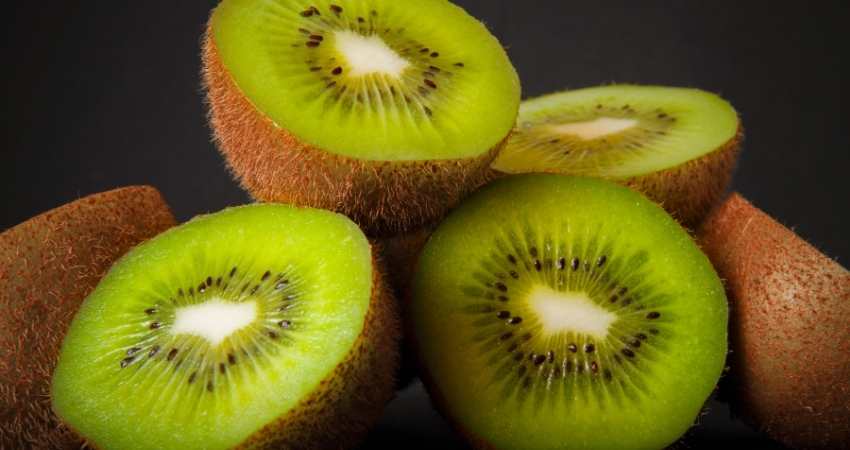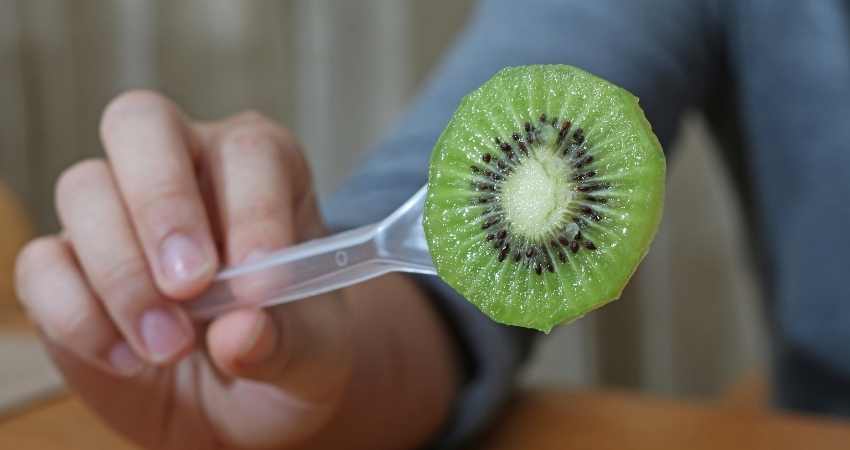Can You Eat The Whole Kiwi?
Can you eat the whole kiwi?
Kiwi fruit is entirely edible, skin included. Most people who eat kiwi fruit regularly do not eat the skin due to its texture. Kiwi fruit skin contains a high amount of fiber, folate, and other vitamins and is quite good for you.
As a Certified Health Coach many people ask me about popular fruit including kiwi. The skin always comes up in conservation. Also, I consume it myself almost every day. I have researched this topic in the past and present.
We’ll dive into the kiwi fruit in this article and examine its features and discuss a little bit more about eating it.

Can You Eat An Entire Kiwi?
Many people ask the question can you eat an entire kiwi. When a person asks this question, they are naturally referring to the kiwi skin or the seeds. As everyone who eats kiwis knows, you can eat the entire inside flesh of the fruit, including the seeds.
It is common practice to cut a kiwi in half. Using a spoon, scoop out the delicious and juicy green or yellowish fruit flesh from the skin’s inside, disposing of the skin afterward. However, many people don’t know you can eat the skin.
As mentioned, kiwi skin contains many health benefits. It contains fiber folate and also vitamin E. However the fuzzy texture of the skin can be unappealing for people to eat it.
This dislike of the texture is most unfortunate as most of the antioxidants found in kiwi fruit are actually in the skin1. These come in the form of vitamin C and vitamin E2.
When I make a smoothie, I often add a whole kiwi after trimming off the hard edges. This way I gain the added benefits of the skin.
Which Part Of Kiwi Is Edible?
As we’ve discussed, every part of the kiwi is edible, including the entire fleshy center, the fruit’s seeds, and the skin. Skin that contains the most antioxidants in the fruit is pound-for-pound, more nutritious than the fruit’s flesh3.

Can Eating Kiwi Skin Harm You?
Eating the skin of kiwis is not harmful. However, there are a few things to consider when eating kiwi skin.
- Skin cleanliness
- Mold or fungus
- Pesticides herbicides or fungicides
Skin Cleanliness
When you go to the supermarket and find the kiwis for sale, frequently they’re merely sitting in a large bin in the store’s produce section. That said, it’s easy enough to pick them up with your hands and put them in your cart, touching the skin, of course. But what if ten people before you picked that kiwi up and then set it back down?
It is essential when you bring kiwifruit home from the grocery that you thoroughly wash it before storing it either in your refrigerator or anywhere else in your home.
Because the public handles kiwi fruit raw skin, take caution when eating the raw skin unless thoroughly cleaning the fruit.
Mold Or Fungus
Before you eat the kiwi fruit in its entirety, you will want to inspect the skin for any mold or fungus. One would assume that one had previously washed the kiwi off. This would be to remove any dirt or contaminants that may have been passed on by other people touching it at the supermarket.
However, if the kiwi fruit has been sitting around your house for a few days, it is highly possible contamination with mold has occurred. Not to say there is mold in your home, but there is mold in the air everywhere on Earth, and eventually, kiwi fruit will rot.
Before you eat the kiwi fruit, examine it thoroughly. You want to look for any small black specks or spots and any apparent black, grey, or white mold that may be growing on the skin.
If you find any mold or fungus growing on the skin, do not eat it and discard it.

Pesticides, Herbicides, Or Fungicides
The last real concern about eating kiwi skin is whether the kiwis are from an organically grown source.
Kiwis that are non-organic may have traces of pesticides or herbicides or even fungicides on the skin or even penetrate the fruit’s skin4. In some cases, these chemicals can even transfer to the flesh of the fruit itself during the growing process.
Paying particular attention to where you get your kiwis is essential if you will eat the skin.
How Many Kiwis Can You Eat A Day?
Kiwifruit, although delicious and nutritious, is also known to have high levels of oxalates5. These can form kidney stones at higher levels.
Due to the risk of kidney stones from too high levels of oxalate, it is important to only eat up to about two kiwi fruit per day maximum.
Some will argue it would take an awful lot of kiwis to cause kidney stones to form, which may be right for some people. However, kiwifruit is so nutritious and has high amounts of sugar that it just doesn’t make sense to eat more than a couple of the fruit per day.
That said, it is a good idea to include kiwi fruit in your diet. Eating half of a kiwi to a full kiwi per day one would assume to be a good idea.
If you have any questions to ask me about this article don’t hesitate to comment below or email us. You can find an email on our contact page.
Read Next – More Anti-Aging Foods!
A Guide To Blueberry Types And Taste
This is When Mangoes Are REALLY Ready to Eat
Mango Skin Magic – Secrets of the Mango Skin!
- National Center for Biotechnology Information: The 2015 Dietary Guidelines Advisory Committee Scientific Report: Development and Major Conclusions [↩]
- USDA: A new vitamin E from kiwi [↩]
- National Center for Biotechnology Information: Characterization of physiochemical and microbiological properties, and bioactive compounds, of flour made from the skin and bagasse of kiwi fruit [↩]
- USDA: Pesticide Residue Monitoring 2015 Report and Data [↩]
- Food and Agriculture Organization of the United Nations: Calcium oxalate crystals: the irritant factor in kiwifruit [↩]
